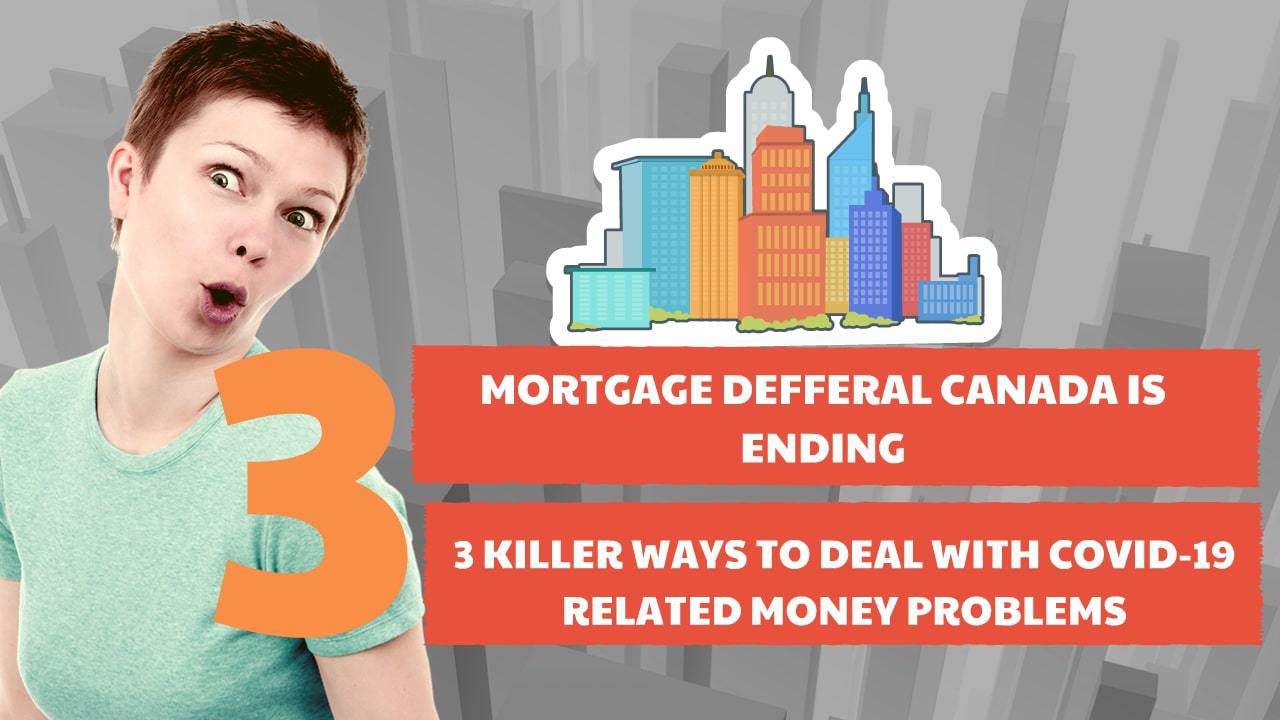The Ira Smith Trustee Team is absolutely operational and Ira, in addition to Brandon Smith, is readily available for a telephone consultation or video meeting. We hope that you and your family are safe and healthy.
[monkeytools msnip=”https://monkeyplayr.com/playr.php?u=5173&p=22438″]
Mortgage deferral Canada introduction
The bulk of the home mortgage deferral Canada that banks have given to Canadians was approved in March and April. This was the time when the COVID-19 pandemic began taking a financial toll on the country with non-essential businesses shuttered and millions unemployed or seeing their earnings take a deep cut.
The Office of the Superintendent of Financial Institutions (OSFI) proposed actions planned to support federally regulated lenders to make sure that they would not experience problems due to the mortgage deferrals provided to help Canadians. The OSFI mortgage deferral help it provided to the lending institutions enhanced the security of the Canadian economic situation and monetary system when faced with obstacles postured by the coronavirus.
The mortgage deferrals are slowly coming to an end. This Brandon’s Blog discusses what you can do if you fear what your personal fallout will be when the mortgage deferrals end.
How did mortgage deferral Canada work for the borrower?
As of July 30, there were approximately $170 billion in mortgage deferments for the biggest 6 banks. The majority were established to unwind by September 30. Mortgage deferral Canada arrangements between Canadians and their financial institutions were truly an individual conversation. The federal government provided a wide overview, yet the specific arrangements between each borrower and lender were established individually as each case required. The significant style was that if a customer was struggling with financial difficulty because of the COVID-19 lockdown, mortgage payments would be deferred for an agreed-on, short-term amount of time.
Currently, these mortgage deferral Canada setups are slowly ending. The chartered banks are reporting that currently, for those whose deferments have ended, 80% to 90% are current in their payments. That means 10% to 20% of people who had a mortgage deferral Canada deal currently cannot maintain their mortgage payments.
How did mortgage deferral Canada work for the lenders?
OSFI told the federally regulated lending institutions and mortgage insurers they can deal with home mortgage financings for which a payment deferment is approved as being current. Payment deferments of as much as 6 months approved prior to August 31 and repayment deferments of up to 3 months approved after August 30 and on or before September 30 that it need not categorize such mortgages as impaired or revamped.
In April OSFI advised lenders that in circumstances where banks provide home mortgage repayment deferrals, those mortgages can continue to be dealt with as performing loans under the . Consequently, OSFI told the banks they did not need to increase their capital resource requirements based upon the home mortgage deferral Canada arrangements they provided. OSFI additionally told the loan providers that it would not assess such mortgage portfolios as having a larger credit risk.
For all federally regulated banks, OSFI specified that it is prepared to use flexibility for any that might need additional time to satisfy upcoming due dates for filing regulatory returns, on a case-by-case basis.
Where mortgages need to be insured due to being high ratio, there are insurance coverage costs that the lending institutions need to make to the insurer each month. OSFI likewise aided the banks and insurers, such as CMHC, by stating that it will not place the lenders or insurers offside when the monthly insurance premiums were not being paid as a result of the mortgage deferral Canada arrangements. OSFI also stated that deferments will not boost capital charges on unpaid premiums. OSFI told insurance providers that they can deal with a mortgage for which a deferment is granted as performing.
So with these OSFI initiatives, lenders can make mortgage deferral Canada happen and both lenders and mortgage insurance providers can treat the mortgages under these deferred home mortgage settlements and mortgage insurance payments, as not being in default.
Mortgage deferral Canada is ending – what can you do if you believe it will cause financial problems for you
OSFI has just stated that any type of mortgage deferral Canada plans past September 30, 2020, will now be subject to OSFI’s typical policies. People who need to start making their mortgage payments once again, but whose economic situation has not improved since the pandemic hit, are scared. I have read some “what to do” articles if you think you will have trouble making your normal mortgage payments. In my view, several have actually missed the mark. Some I have checked out start explaining how a consumer proposal or bankruptcy can help you.
Just so you know, a consumer proposal or bankruptcy cannot help you with the end of your mortgage deferral Canada. The reason it cannot help you is that your mortgage is a secured debt. Your mortgagee is a secured creditor, assuming its mortgage security is valid. A consumer proposal or bankruptcy is a method of dealing with your unsecured creditors. The mortgagee has rights if you default on your mortgage whether or not you are involved in a formal insolvency process. If you have too much debt and too little income to service all that debt, you may very well need to consider an insolvency filing. But it is not a direct answer to your mortgage deferral Canada ending.

So in order, here are my 3 top recommendations of what you could do when your mortgage deferral Canada deal with your lender ends and you believe you will be in financial trouble.
- Take a critical look at your family household budget
I cannot emphasize enough just how essential the household budget is to your financial security. A spending plan is a listing of all income and your families’ costs. Do it on a monthly basis. It enables you to prepare how you need to spend your money and if there is anything left over each month for savings for an emergency fund or for investment. Rather than cash just flying out of your pocketbook, you make intentional choices on where you want your cash to go. You’ll never need to doubt at the end of the month where your money went or search for a hole in your wallet.
Numerous Canadians panic every month regarding where the cash will come from to pay their bills. A household budget will give you the direction you need. That direction should give you comfort. It reveals to you just how much you make and also what your costs are. If need be you can decrease unneeded costs or possibly tackle extra work to live within a well-balanced budget plan. No extra panicking at the end of the month.
So if you have a household budget that you follow, look at it carefully. If you don’t’ have one, prepare it immediately. Look at the last 6 months and see what your average monthly income has been and what your average monthly expenses were. List them all out line by line for both income and expenses. Then adjust any line that you believe will change in the coming months. Adding your normal monthly mortgage payment is one of those things that will need to be added.
Then take a look at it and see if you are spending less or more than you earn. If you are spending more, then you need to cut back on certain expenses, increase your income, or a combination of both. Take a critical look and slash any expenses that you can. Then see what that looks like.
If you feel that making your normal monthly mortgage payment will not be a problem, then terrific. Just follow your family budget and each month compare your actual to budget. Make any adjustments you need to along the way. However, keep spending less than you earn.
If your budget shows that you are going to have trouble making your normal monthly mortgage payment, then go on to my next step 2.
- Speak to your banker
Get ahead of it. Contact your lender. Let them know that you have a current family budget and it shows that you may need added help when your mortgage deferral Canada deal ends. Your banker will be impressed that you:
- have a current budget that you are tracking; and
- you are being proactive and not causing the banker to chase you because you came up on the computer screen as a delinquent mortgagor.
That already makes you the most liked person in the 10% to 20% of people who are experiencing problems paying their mortgage. Hopefully, your lender can work something out for you that will help you.
- Call me
If your budget shows that you do not have enough family income to pay all the families’ debts on a monthly basis and your lender cannot do anything to help you, then call me. I will take a critical look at your family budget and get more personal financial details from you. After reviewing all of it, I will give you my best recommendations to meet your unique financial challenges. Keep in mind that this is not your fault. The COVID-19 pandemic and the resulting shutdown of the Canadian economy continues to cause problems for the majority of Canadians.
Mention this blog, and I will not charge you a penny for this help. I truly want you to succeed.
Mortgage deferral Canada summary
I hope you have found this mortgage deferral Canada Brandon’s Blog interesting and helpful. The Ira Smith Team family hopes that you and your family members are remaining secure, healthy and well-balanced. Our hearts go out to every person that has been affected either via misfortune or inconvenience.
We all must help each other to stop the spread of the coronavirus. Social distancing and self-quarantining are sacrifices that are not optional. Families are literally separated from each other. We look forward to the time when life can return to something near to typical and we can all be together once again.
Ira Smith Trustee & Receiver Inc. has constantly used clean, safe and secure ways in our professional firm and we continue to do so.
Income, revenue and cash flow shortages are critical issues facing entrepreneurs, their companies and individual Canadians. This is especially true these days.
If anyone needs our assistance for debt relief Canada COVID-19, or you just need some answers for questions that are bothering you, feel confident that Ira or Brandon can still assist you. Telephone consultations and/or virtual conferences are readily available for anyone feeling the need to discuss their personal or company situation.
The Ira Smith Trustee Team is absolutely operational and Ira, in addition to Brandon Smith, is readily available for a telephone consultation or video meeting. We hope that you and your family are safe and healthy.





